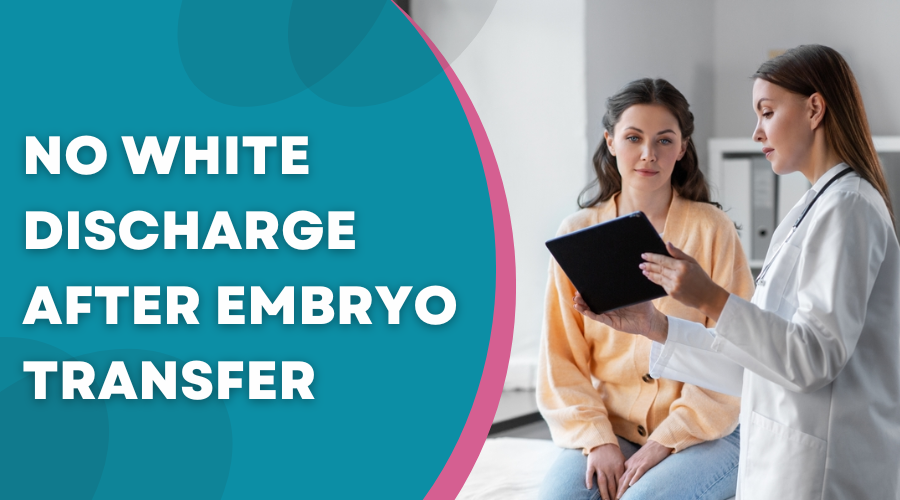Embryo transfer plays a significant role during the IVF journey, filled with hope and anticipation. Among the many changes a woman may experience after this procedure, vaginal discharge is often one of the most discussed topics. White discharge is typically associated with hormonal changes in early pregnancy, but what happens when there’s no discharge?
According to Dr. Nisarg Patel, a renowned fertility specialist and founder of Nisha IVF Centre in Ahmedabad.
“White discharge after embryo transfer occurs due to rising progesterone levels, which help prepare the uterus for implantation. However, some ladies may not experience white discharge, which doesn’t necessarily mean the embryo transfer wasn’t successful.”
This blog covers the key reasons behind the absence of white discharge after embryo transfer, whether it’s a cause for concern, and what steps you can take if you experience it.
Eager about the timing of post-transfer changes? Let’s explore what to expect in the coming days.
When to Expect White Discharge After Embryo Transfer and How Long It Lasts?
White discharge after an embryo transfer is often due to hormonal fluctuations, particularly progesterone, which plays a crucial role in preparing the body for pregnancy. Many women notice a thick, white, or milky discharge within some days of the transfer. This can last several weeks as progesterone levels rise to support the embryo’s implantation and growth.
However, the timing and duration can vary. Some women experience discharge within days, while others might notice it later in the cycle. The amount of discharge also differs, with some experiencing heavy discharge while others barely see it.

Are you feeling unsure about the absence of white discharge? speak with a seasoned fertility specialist to get expert insights and reassurance.
Let’s explore whether no white discharge after embryo transfer is common and what it might mean.
Is Lack of White Discharge After Embryo Transfer Normal?
While many women experience discharge due to increased progesterone, others may have little to no discharge. It’s natural to wonder whether the absence of white discharge is normal after embryo transfer.
Dr. Nisarg Patel, a distinguished fertility doctor in Ahmedabad, says:
“It’s crucial to understand that every patient’s response to IVF is unique. The absence of discharge doesn’t always indicate a problem. Some women may have more discreet symptoms or none at all, but it doesn’t mean the embryo transfer was unsuccessful. What matters most is how your body adjusts overall and for you to stay calm. Discharge is just one of many potential signs, but it’s not the only one that counts.”
Let’s examine what it could mean if there is no white discharge after embryo transfer.
Possible Reasons for the Absence of White Discharge after Embryo Transfer
There are several reasons why you might not experience white discharge after embryo transfer:
Medications: IVF treatments often involve medications that can affect vaginal discharge. Certain hormones or progesterone supplements may lead to reduced discharge.
Hormonal Variations: Not all bodies respond the same way to hormonal shifts. Some women may have less cervical mucus production despite increased progesterone.

Natural Variability: Simply put, no two women are alike. The absence of discharge could be due to natural body variability and not a reflection of pregnancy success.
These reasons are generally not a cause for concern, but it’s always best to speak with your doctor if you have questions.
So, what does the absence of white discharge indicate? Let’s uncover whether it’s a favorable or unfavorable sign.
No White Discharge After Embryo Transfer: A Positive or Negative Indicator?
The occurrence or lack of white discharge after embryo transfer doesn’t necessarily indicate pregnancy success or failure. Many women who don’t have any noticeable discharge still go on to have successful pregnancies.
Conversely, having discharge does not mean a guaranteed sign of implantation. It’s important to remember that other early pregnancy symptoms, such as mild cramping or breast tenderness, may provide more accurate insights into the outcome of the embryo transfer.
Now that you know what it means, let’s look into what steps to take if you experience no discharge.
What to Do If There's No White Discharge After Embryo Transfer?
If you don’t notice white discharge after your embryo transfer, there’s no need to panic. Instead:
Monitor Other Symptoms: Track any other early pregnancy signs, like cramping, breast soreness, or bloating. These may offer more clues than discharge alone.
Consult Your Doctor: If you’re concerned, don’t hesitate to contact your doctor. They can provide reassurance and may recommend tests, such as a blood test, to confirm pregnancy.
Stay Positive: Remember, everybody reacts differently to pregnancy. The absence of white discharge does not mean your embryo transfer wasn’t successful.

Conclusion
The absence of white discharge after embryo transfer may leave you questioning the outcome, but it’s important to remember that this isn’t necessarily a negative sign. Each woman’s body responds differently to the hormonal changes that occur during IVF, and a lack of discharge is often just a variation of normal.
The best approach is to stay in close communication with your doctor, monitor other early signs, and maintain a positive outlook throughout the process.
Are you concerned by the lack of discharge after your procedure? Consult a reliable IVF doctor to help you interpret your symptoms and guide you forward.
Got more questions? Our FAQ section addresses some common concerns that you may have.
FAQs
Can stress after embryo transfer affect vaginal discharge?
Yes, stress can influence many aspects of your body, including hormone levels, potentially altering the amount and consistency of vaginal discharge.
Does the absence of white discharge mean I should change my medication?
No, unless your doctor advises it. Medications are carefully prescribed based on your body’s needs, and discharge is not always a reliable indicator of their effectiveness.
How soon can I have a pregnancy test if I have no symptoms after embryo transfer?
It’s best to wait at least 10-14 days after embryo transfer for a pregnancy test, regardless of whether you have symptoms like discharge or not.
Can I have a successful pregnancy without experiencing any common symptoms like discharge or cramping?
Yes, some women have little to no symptoms after embryo transfer and still have successful pregnancies. Each body is unique.
Does diet or hydration affect the likelihood of having white discharge after embryo transfer?
Yes, both diet and hydration can influence vaginal discharge after embryo transfer.
- Staying well-hydrated helps maintain a healthy uterine lining, which supports implantation.
- A balanced diet rich in essential nutrients can support overall reproductive health and potentially impact discharge.
However, while these factors contribute to a healthy environment for the embryo, they are not the sole determinants of discharge presence or absence.
Disclaimer: The information shared in this content is for educational purposes only and not for promotional use.


